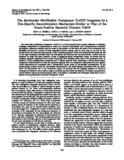The Bacteroides mobilizable transposon Tn4555 integrates by a site-specific recombination mechanism similar to that of the gram-positive bacterial element Tn916
Author
Tribble, Gena D.; Parker, Anita C.; Smith, C. Jeffrey
Abstract
The Bacteroides mobilizable transposon Tn4555 is a 12.2-kb molecule that encodes resistance to cefoxitin. Conjugal transposition is hypothesized to occur via a circular intermediate and is stimulated by coresident tetracycline resistance elements and low levels of tetracycline. In this work, the ends of the transposon were identified and found to consist of 12-bp imperfect inverted repeats, with an extra base at one end. In the circular form, the ends were separated by a 6-bp “coupling sequence” which was associated with either the left or the right transposon terminus when the transposon was inserted into the chromosome. Tn4555 does not duplicate its target site upon insertion. Using a conjugation-based transposition assay, we showed that the
coupling sequence originated from 6 bases of genomic DNA flanking either side of the transposon prior to excision. Tn4555 preferentially transposed into a 589-bp genomic locus containing a 207-bp direct repeat. Integration occurred before or after the repeated sequence, with one integration site between the two repeats. These observations are consistent with a transposition model based on site-specific recombination. In the bacteriophage lambda model for site-specific recombination, the bacteriophage recombines with the Escherichia
coli chromosome via a 7-bp “crossover” region. We propose that the coupling sequence of Tn4555 is analogous in function to the crossover region of lambda but that unlike the situation in lambda, recombination
occurs between regions of nonhomologous DNA. This ability to recombine into divergent target sites is also a feature of the gram-positive bacterial transposon Tn916. Originally published Journal of Bacteriology, Vol. 179, No. 8, Apr 1997
Date
1997-04
Citation:
APA:
Tribble, Gena D., & Parker, Anita C., & Smith, C. Jeffrey. (April 1997).
The Bacteroides mobilizable transposon Tn4555 integrates by a site-specific recombination mechanism similar to that of the gram-positive bacterial element Tn916.
Journal of Bacteriology,
179(8),
2731-
2739. Retrieved from
http://hdl.handle.net/10342/3140
MLA:
Tribble, Gena D., and Parker, Anita C., and Smith, C. Jeffrey.
"The Bacteroides mobilizable transposon Tn4555 integrates by a site-specific recombination mechanism similar to that of the gram-positive bacterial element Tn916". Journal of Bacteriology.
179:8. (2731-2739),
April 1997.
June 29, 2024.
http://hdl.handle.net/10342/3140.
Chicago:
Tribble, Gena D. and Parker, Anita C. and Smith, C. Jeffrey,
"The Bacteroides mobilizable transposon Tn4555 integrates by a site-specific recombination mechanism similar to that of the gram-positive bacterial element Tn916," Journal of Bacteriology 179, no.
8 (April 1997),
http://hdl.handle.net/10342/3140 (accessed
June 29, 2024).
AMA:
Tribble, Gena D., Parker, Anita C., Smith, C. Jeffrey.
The Bacteroides mobilizable transposon Tn4555 integrates by a site-specific recombination mechanism similar to that of the gram-positive bacterial element Tn916. Journal of Bacteriology.
April 1997;
179(8):
2731-2739.
http://hdl.handle.net/10342/3140. Accessed
June 29, 2024.
Collections
Publisher
East Carolina University

